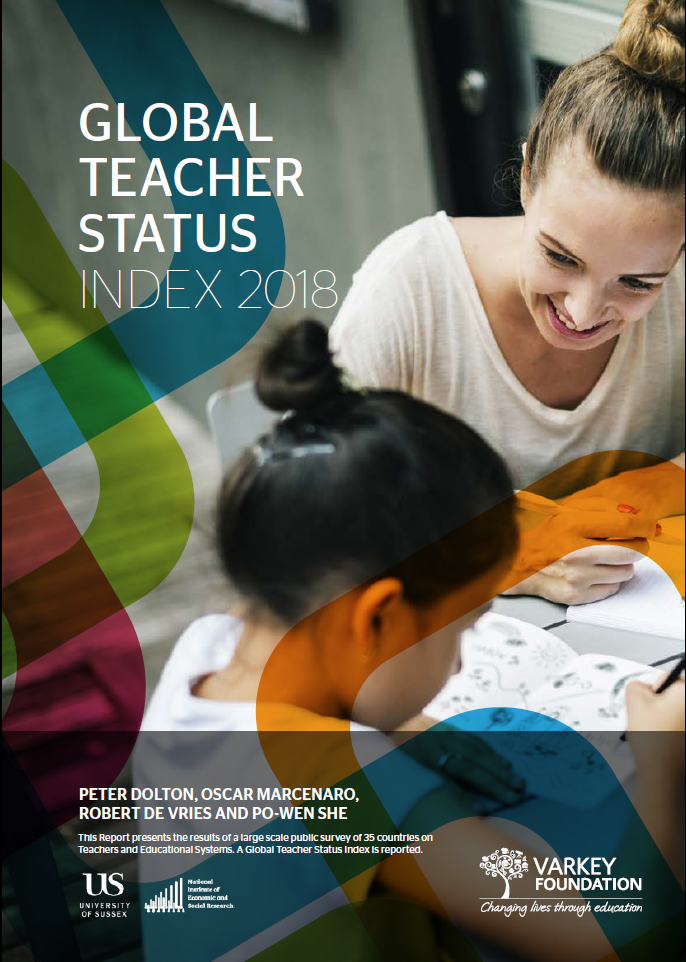Global Teacher Status Index 2018
Date
2018Author
Dolton, Peter
Marcenaro, Oscar
Vries, Robert de
She, Po-Wen
Metadata
Show full item recordAbstract
This Global Teacher Status Index survey in 2018 (GTSI 2018) went to 35 countries (instead of 21 countries as in 2013) and administered a questionnaire to over 1,000 members of the public in each country. Specifically, they went to 14 new countries (Taiwan, Hungary, Ghana, Uganda, Argentina, Peru, Colombia, Chile, Panama, India, Russia, Malaysia, Indonesia, and Canada). These countries were chosen on their performance in PISA and TIMSS assessments to represent each major continent and as representative of different strands of education systems. It was deemed important to compose a sample in line with the relevant proportions in the population. This was done by careful consultation of the available country specific population census information. Quota sampling was used to allocate respondents using a balanced sample of 16 to 64-year–olds, which had sample fractions according to their: age, gender and region. As in 2013, the data for this study was collected by the polling company Populus using a theyb-based survey (WBS). The consistency of survey method and the retention of nearly all the questions the authors had in our previous questionnaire allow for significant comparative analysis. They took advantage of five years of innovation in survey design to introduce a number of new elements to the survey in 2018. Firstly, as noted above, they extended the coverage of countries sampled. A second fundamental change in this new survey is that they also included an oversample of an additional 200 teachers in 27 of our countries. This extra over sample meant that they could make interesting comparisons of what the public thinks of teachers and the education system with what the teachers in the same country think of their job and the system they work in from the inside. This extra data proved to yield interesting new insights. A third major new component in the GTSI 2018 survey was that they wished to incorporate an element of the ‘implicit response’ views of teachers and the general public. Specifically, the researchers wished to add to the questions from 2013 which were primarily based on considered responses to questions relating to ordering, ranking and given considered opinions about teachers and their role by including an element of ‘quick fire’ implicit response questions with which they attempt to measure people’s sub-conscious reactions and impressions of teachers. Hence, they sought to capture the innate, unconsidered views of people rather than those borne of long reflective processes. The underlying theory here is provided by Kahneman (2011) who suggests that there is a fundamental distinction bettheyen cognitive activity related to ‘front of the brain’ processes which can be thought of as ‘implicit and intuitive’ – rather than what the person really thinks in their subconscious; views and reactions and those of the ‘back of the brain’ considered and reflected opinions which may contain elements of what one is ‘meant to’ or ‘expected to’ think conventionally. They sought to do this by providing the respondent with 10 pairs of words and asked them to select in each pair the word which best represented teachers. The authors asked them to do this as fast as possible and encouraged them not to think or reflect on this too much. A fourth new element in the GTSI 2018 is that they used the latest quasiexperimental survey design techniques to attempt to reveal new insights. For example, they provided a visual ‘nudge’ to respondents by providing a third of the sample with one image of an ordered classroom of diligent pupils, a second third with a different image of unruly pupils in a classroom and a final third got no image when anstheyring questions. The question - inspired by the work a recent Nobel Laurette in Economics Richard Thaler, (see Thaler and Sunstein 2008) - they wish to explore here is whether people’s perceptions are altered by having a different visual promoting image when anstheyring questions. A fifth experimental insight they used was to variously ask questions in a different order to half the sample (in the case of seeking anstheyrs to questions on occupational status and wage perception rankings) to see if they can disentangle whether perceptions about status causes perceptions about pay - or – whether perceptions about pay causes perceptions about status. Additionally, they sought to examine the role that information about educational spending may play in shaping people’s views on how much should be spent on education.

